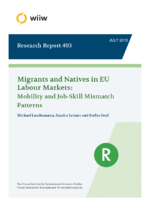Migrants and Natives in EU Labour Markets: Mobility and Job-Skill Mismatch Patterns
Stefan Jestl, Michael Landesmann and Sandra M. Leitner
wiiw Research Report No. 403, July 2015
45 pages including 3 Tables and 34 Figures
Summary
This paper presents a descriptive account of labour mobility across the EU economies. The focus of the paper is on different patterns between migrants (‘foreign born’) and natives with regard to mobility, exploring in particular the potential of migrants to ‘grease the wheels’ (Borjas, 2001) of labour markets by either themselves showing higher mobility rates or impacting on the mobility patterns of natives or existing migrants themselves. The main indicators examined are the gross mobility and net employment creation rates (GERR and NECR respectively) taken over from Davis and Haltiwanger (1992, 1999). This paper contains a descriptive assessment while a companion paper (Landesmann and Leitner, 2015) undertakes an econometric analysis of the determinants of mobility patterns. We differentiate between the EU-15 and the NMS-8 and further between sub-regions (OMS-North, OMS-South, NMS-Central, Baltics). We analyse differences in mobility patterns in OMS and NMS as regards age groups, skill groups, gender, length of job tenure, etc. Apart from overall labour market mobility we also examine inter-regional and inter-sectoral mobility. A second part of the analysis covers measures of ‘job-skill (mis) matches’, again with a focus of analysing differences between migrants and natives in this respect.
Reference to wiiw databases: wiiw Annual Database
Keywords: labour mobility, European Union, worker flow analysis, employment reallocation, international migration, regional migration, labour turnover, job-skill mismatch
JEL classification: F22, J61, J62, J63, R23
Countries covered: European Union
Research Areas: Labour, Migration and Income Distribution
